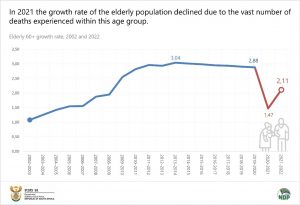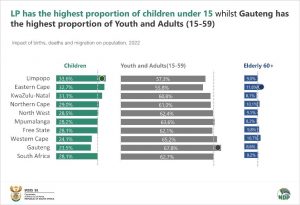60,6 million people in South Africa
The population of South Africa is estimated to be 60,6 million by the end of June 2022. Between 2002 and 2022 South Africa experienced a positive population growth year-on-year. A positive growth rate indicates that the population is increasing, despite the devastating impact of COVID-19 globally and within South Africa’s borders.
By 2022, measures of mortality indicate an improvement in Life expectancy at birth moving from 61,7 years in 2021 to 62,8 years in 2022. As the nation grappled with the pandemic, it brought attention not only to the importance of health care and other social services required by people, but also to the age profile of the population and the vulnerability of key populations in the country.
The elderly population, who are more vulnerable to having comorbidities, are more likely to experience the devastating effects of COVID-19. The vast number of deaths within this age group occurring during the COVID-19 pandemic led to a drastic decline in the growth rate (1,47%) of the elderly population. By 20 June 2021, South Africa fast-tracked their COVID-19 vaccination programme to ensure healthcare workers and people aged 60 years and above were vaccinated. The impact of such a health intervention not only saved the lives of those age 60 and older but also those transitioning into the elderly age group, resulting in an increased rate of growth among the elderly population (2,11%) by 2022.
This is not the first pandemic that South Africa has had to endure. South Africa has paid a large price demographically due to the AIDS pandemic. In conjunction with losing economically active adults due to HIV/ AIDS deaths, which impacted negatively on the demographic dividend, infant and child mortality reduced overall life expectancy in the country for a number of years. Whilst the age profile of the COVID-19 pandemic was vastly different, South Africa is yet to unpack the impact of the increased morbidity, mortality and change in migratory patterns over the last 2 years.
The Mid-year population estimates (MYPE) offers key indices and estimates regarding births, deaths and migratory movements in the country as well as key estimates by age, sex and geographical data that assist in planning for and addressing the needs of the population. The upcoming Census 2022 results will be a key source of data to update those estimates and indices. Census will also assist in improving future projections as well as provide granular level data that is needed to identify and target essential services and needs. The participation of each and every person in the census is key to local planning and service delivery.
In 2022, the MYPE indicates that about 28,07% of the population is aged younger than 15 years (17,01 million) and approximately 9,2% (5,59 million) is 60 years or older. The provinces reflecting the highest percentage of children younger than 15 within its structure are Limpopo (33,6%) and EC (32,7%). Gauteng still comprises the largest share of the South African population, with approximately 16,10 million people (26,6%) living in this province. KwaZulu-Natal is the province with the second largest population, with an estimated 11,54 million people (19,0%) living there. With a population of approximately 1,31 million people (2,2%), Northern Cape remains the province with the smallest share of the South African population.
The 2022 Mid-Year population estimates does not include inputs from the census conducted in 2022. Census data will be released in 2023 and these will be built into the 2024 estimates. Subsequently, there will be no mid-year population estimates report next year.
For more information, download the full report on our website at www.statssa.gov.za or follow the link here.



